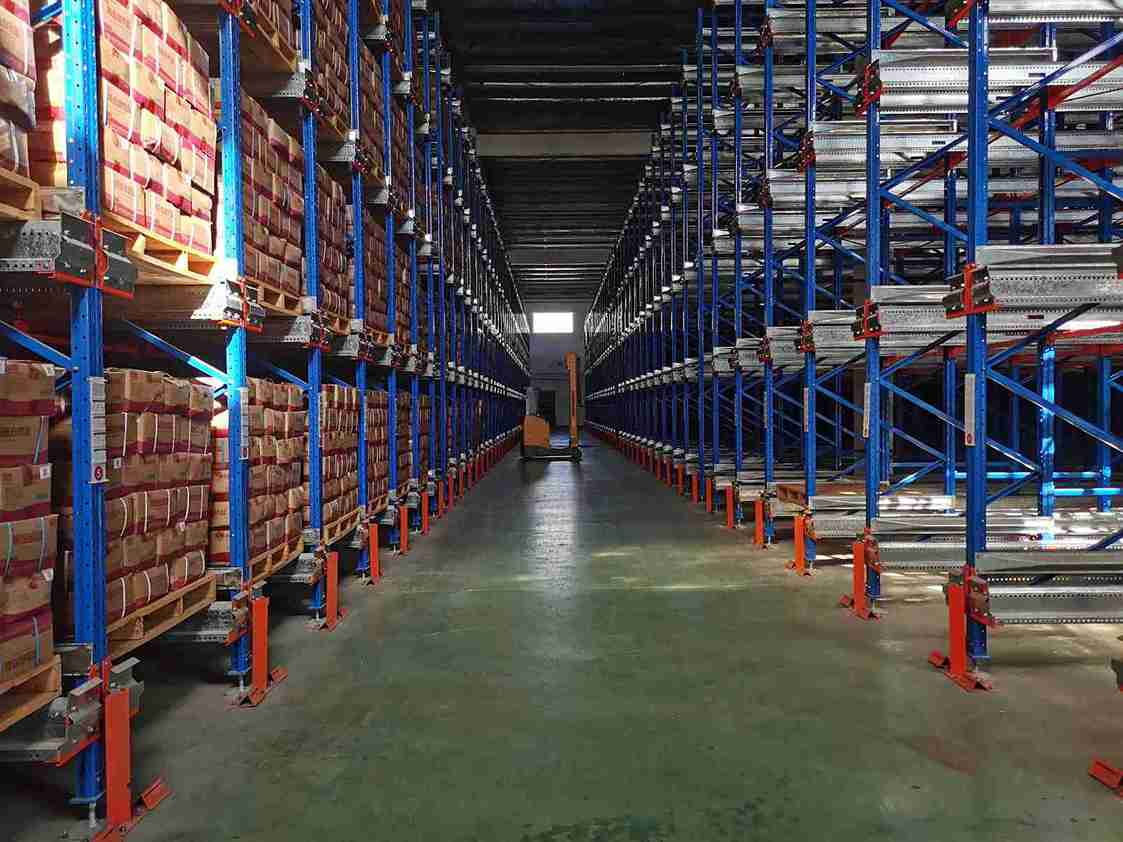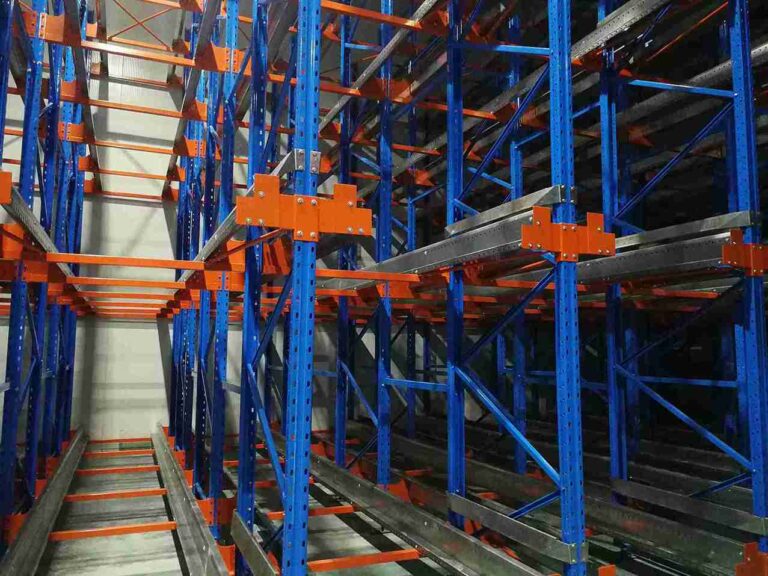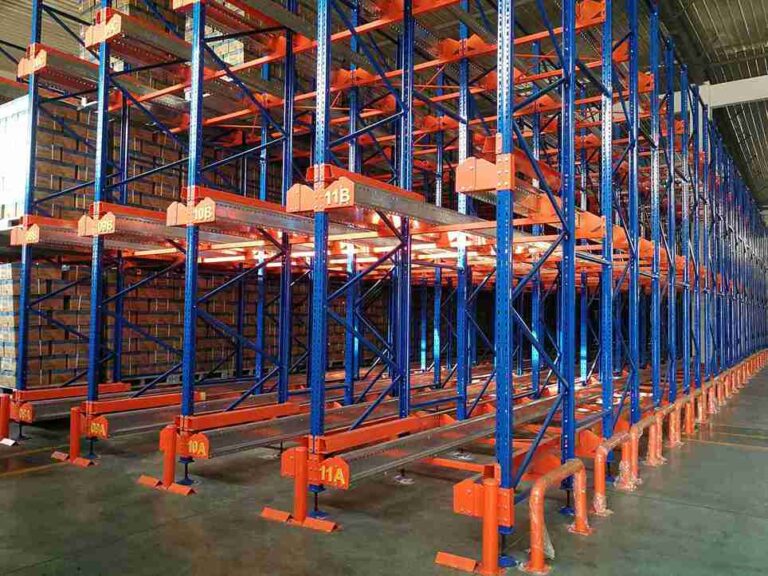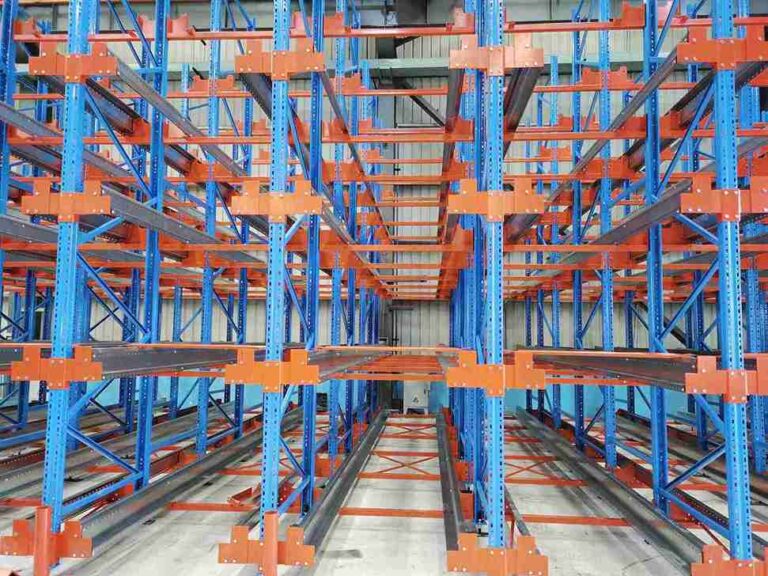📐 "First 50 Enterprise Queries Get Custom 3D Warehouse Design" Plan

In the relentless pursuit of supply chain superiority, logistics center managers face a universal and costly adversary: the inefficient use of space. As e-commerce demands soar and SKU counts explode, traditional storage methods are hitting their physical and economic limits, creating a critical imperative for high-density solutions.
The answer, increasingly adopted by industry leaders, is not merely about adding more square footage but about revolutionizing the storage cube through intelligent automation. This comprehensive analysis delves into why shuttle racking for logistics centers has become the benchmark for modern storage optimization.
It provides a meticulous examination of how this technology directly confronts the core inefficiencies of labor, space, and accuracy that plague modern warehouses. From a detailed breakdown of its operational mechanics and integration capabilities with broader automation ecosystems to a frank discussion of implementation hurdles and total cost of ownership, this resource is designed to be an indispensable guide for any logistics professional considering a transformative investment. The objective is to deliver not just information, but actionable insights that underscore the strategic value of implementing a sophisticated shuttle racking for logistics centers solution.

H2: The Squeeze is On: A Deep Dive into the Modern Shuttle Racking For Logistics Centers Storage Crisis
The contemporary logistics center operates at the nexus of immense pressure. The dual forces of consumer demand for faster delivery and an ever-expanding array of products collide with the harsh realities of soaring real estate costs and a strained labor market. The traditional model of wide-aisle warehouses, dependent on forklifts and manual navigation, is increasingly revealed as a significant bottleneck and a direct drain on profitability. The central challenge transcends simply storing more goods; it revolves around achieving rapid, accurate, and cost-effective access to inventory within a constrained footprint.
This crisis is fundamentally about the volumetric efficiency of the facility—the cubic airspace that often goes underutilized. Conventional selective pallet racking systems typically achieve a volumetric space utilization of only 45% to 55%. The remainder is perpetually consumed by access aisles. Each aisle represents a double loss: it is valuable floor space that generates no storage revenue while incurring costs for lighting, climate control, and maintenance.
This inherent inefficiency is the primary high-density storage challenge that solutions like shuttle racking for logistics centers are engineered to address. For decision-makers, the equation is simple: expanding a building’s footprint is often prohibitively expensive or logistically impossible. The most viable strategic path forward, therefore, lies in radically optimizing the existing infrastructure. The implementation of a high-density system is not an optional upgrade but a strategic necessity for businesses aiming to scale efficiently and maintain competitiveness.
H2: Shuttle Racking For Logistics Centers Demystified: The Core Engine of Modern Storage Automation
At its essence, shuttle racking for logistics centers is a semi-or fully-automated storage and retrieval system that redefines the very concept of a storage aisle. It transforms static racking from a passive storage fixture into an active, dynamic participant in the material handling process. Imagine a multi-story building for pallets where a robotic elevator—the shuttle—operates within the rack structure itself, traversing storage lanes without the need for a forklift to enter.
The operational workflow of shuttle racking for logistics centers can be broken down into a precise, coordinated sequence:
The Receiving Point: A pallet arrives at the designated Pick-Up and Deposit (P&D) point at the front of the racking system. This is typically the only point where human operators or complementary automated guided vehicles (AGVs) interact directly with the system.
System Command: The Warehouse Management System (WMS), integrated with the shuttle system’s software, identifies the optimal storage location based on pre-defined rules (e.g., FIFO, LIFO, product velocity).
Vertical Transport: A vertical lift or crane stationed at the P&D point elevates the pallet to the exact level of the designated storage lane.
Horizontal Deployment: The shuttle cart, which may be dedicated to a specific level or shared across levels via a transfer car, is dispatched. It moves from its home position onto the lift, retrieves the pallet, and transports it deep into the storage lane, placing it in the assigned location.
The Reverse Cycle: For retrieval, the process is executed in reverse. The shuttle fetches the required pallet from its depth within the lane, brings it to the lift, which then lowers it to the P&D point for collection.
This elegant separation of vertical and horizontal movement, managed by intelligent software, is what sets shuttle racking for logistics centers apart. It decouples the operator from the time-consuming travel within aisles, enabling parallel processing and a dramatic leap in throughput.
H2: The Tangible Payoff: A Detailed Analysis of Shuttle Racking For Logistics Centers
The decision to invest in shuttle racking for logistics centers is justified by a compelling array of quantifiable benefits that impact the bottom line.
H3: Unprecedented Space Utilization and Storage Density
The most immediate impact of deploying shuttle racking for logistics centers is the radical increase in storage capacity. By consolidating multiple pallet positions into deep lanes served by a single, narrow access aisle, these systems can increase storage density by 80% to over 100% within the same footprint compared to selective racking.
This transformative gain is achieved by reallocating space previously wasted on aisles into productive storage. For companies operating in high-cost urban areas or in temperature-controlled environments like cold storage warehouses—where the cost per square foot is exceptionally high—the space savings delivered by shuttle racking for logistics centers can justify the investment through real estate avoidance alone.
H3: Supercharged Operational Efficiency and Scalable Throughput
In logistics, speed and accuracy are currencies. Shuttle racking for logistics centers introduces a paradigm of parallel processing. While the automated shuttle is busy placing or retrieving a pallet deep within a lane, the vertical lift and the operator (or AGV) are free to service other transactions.
This concurrent operation drastically reduces single-command cycle times and enables a significantly higher number of pallet movements per hour. The system’s throughput is no longer tied to the speed of a forklift or subject to operator fatigue, breaks, or shift changes. The reliability and consistency of shuttle racking for logistics centers ensure that peak performance can be maintained 24/7 if required.
H3: Drastic Labor Optimization and Enhanced Workplace Safety
Labor constitutes one of the largest and most volatile operational costs. Furthermore, skilled forklift operators are increasingly difficult to recruit and retain. A well-implemented shuttle racking for logistics centers system dramatically reduces the reliance on manual, high-skill forklift operation within narrow aisles.
Operators are repositioned to more ergonomic and cognitively engaging roles at the P&D stations, overseeing the system’s workflow. This shift leads to a substantial reduction in labor costs, lowers the risk of workplace accidents associated with forklift operations, and minimizes product damage caused by impacts—a common and costly issue in traditional warehouses.
H3: Pinpoint Inventory Control and Inherent Compliance
Accuracy in inventory management is non-negotiable. Shuttle racking for logistics centers provides a digital-twin level of control over stock. The WMS knows the exact lane, level, and bay position of every single pallet. This eliminates the errors associated with manual logging and misplacement. Furthermore, the system’s software can be programmed to enforce strict inventory rotation protocols like First-In-First-Out (FIFO) or Last-In-First-Out (LIFO) with absolute precision.
This is a critical feature for industries with perishable goods or strict lot-tracking requirements. Cycle counting becomes a streamlined process that can often be performed with minimal disruption to ongoing operations, thanks to the system’s inherent accuracy.
H2: Shuttle Racking in Action: Identifying Ideal Applications
The effectiveness of shuttle racking for logistics centers is maximized in specific operational profiles. It is not a universal panacea, but its ROI is exceptionally high in the right contexts. Operations that benefit most from shuttle racking for logistics centers typically exhibit several of the following characteristics:
High Volume of homogeneous SKUs: Facilities managing large quantities of a limited number of SKUs, such as beverage distributors, packaged food companies, or large-scale retail distribution centers, are ideal candidates. The system excels at creating dense blocks of similar products.
Cold Storage and Freezer Warehouses: This is arguably one of the most compelling applications for shuttle racking for logistics centers. The exorbitant cost of energy to refrigerate or freeze space makes density paramount. Additionally, minimizing the time human operators spend in extreme temperatures is a significant health, safety, and productivity advantage.
Buffer Storage for Manufacturing and Production: Shuttle racking for logistics centers provides an excellent high-density buffer for raw materials, work-in-progress, or finished goods in manufacturing settings, ensuring a seamless and organized flow to and from production lines.
Businesses Experiencing Rapid SKU Proliferation: Companies facing an explosion in their number of SKUs can use shuttle racking for logistics centers to maintain organization and efficiency amidst growing complexity.
H2: The Nuts and Bolts: A Technical Overview of System Components
A robust and reliable implementation of shuttle racking for logistics centers relies on the seamless interaction of several critical components, each engineered for durability and precision.
H3: The Shuttle Cart: The Intelligent Workhorse
The shuttle cart is the core mobile element of the system. These units are marvels of engineering, designed for relentless operation:
Durable Chassis and Drive System: Built to carry heavy loads (often exceeding 1,500 kg) thousands of times per day with minimal maintenance.
Precision Lifting Mechanism: Forks or a scissor-lift platform that engages and lifts pallets smoothly and securely.
Long-Life Battery and Charging Circuitry: Designed for rapid opportunity charging at the P&D station, ensuring near-continuous operation.
Advanced Sensor Suite: Includes positioning sensors, obstacle detection, and safety systems to ensure flawless and safe navigation within the confined lane.
H3: The Racking Structure: The Backbone of the System
The racking for a shuttle racking for logistics centers installation is not standard warehouse shelving. It is a heavily engineered structure that must serve as both storage and a guide rail for the shuttle carts.
It requires higher load specifications to account for the dynamic forces of the moving shuttles and must be installed with extreme precision to ensure smooth operation. The integrity and accuracy of the entire shuttle racking for logistics centers system are wholly dependent on the quality and installation of this structural backbone.
H3: The Vertical Lift or Crane: The Vertical Conveyor
This component acts as the vertical link between the ground-level P&D stations and the multiple storage levels. It is responsible for elevating pallets to the correct height for the shuttle to engage and transport them horizontally into the racking. The speed and reliability of the lift are crucial for maximizing the overall throughput of the shuttle racking for logistics centers system.
H3: The Warehouse Management System (WMS) Integration: The Brain
The software that controls the shuttle racking for logistics centers is its nervous system. A sophisticated control system does more than just assign locations; it optimizes them in real-time. It uses algorithms to determine the most efficient put-away and retrieval sequences based on turnover rates, expiry dates, and upcoming orders, commanding the shuttle carts and lifts to execute these tasks with flawless coordination.
The depth of integration between the shuttle system’s software and the host WMS is a critical factor in unlocking the full potential of shuttle racking for logistics centers.
H2: Beyond the Shuttle: Integration with a Broader Automated Ecosystem
The true transformative power of shuttle racking for logistics centers is fully realized when it functions not as a standalone island of automation, but as an integrated component within a connected, smart warehouse ecosystem.
Seamless Integration with AGVs and AMRs: Automated Guided Vehicles (AGVs) or Autonomous Mobile Robots (AMRs) can serve as the perfect partners for shuttle racking for logistics centers. They can autonomously transport pallets from the receiving dock to the shuttle system’s P&D station and from the P&D station to the shipping or staging area. This creates an end-to-end, “lights-out” material handling flow that further reduces labor requirements and enhances accuracy.
Synergy with Conveyor Systems and Automated Sortation: For order fulfillment centers, pallets retrieved by the shuttle racking for logistics centers can be fed directly into conveyor systems that transport them to ergonomic picking workstations or to automated sortation systems for cross-docking or parcel sorting, creating a highly efficient goods-to-person solution.
The Command Center: WMS and WCS: The Warehouse Management System (WMS) and the Warehouse Control System (WCS) act as the command center, orchestrating the movements of the shuttles, AGVs, conveyors, and sorters into a perfectly synchronized and highly efficient operation. The data generated by the shuttle racking for logistics centers provides invaluable insights for continuous process improvement.
H2: Is Your Operation Ready? A Strategic Checklist for Adoption
Transitioning to an automated system like shuttle racking for logistics centers is a significant capital investment and operational shift. Logistics managers should conduct a thorough self-assessment using the following checklist:
Pallet Volume and Profile: Does the operation have a sufficiently high and consistent volume of pallet movements to justify the automation? Is the SKU profile suited for high-density storage (fewer SKUs, high depth)?
Cost Pressures: How significant are the current and projected costs for real estate, labor, and energy? High costs in these areas typically accelerate the return on investment for shuttle racking for logistics centers.
Operational Pain Points: Are current operations plagued by low throughput, high error rates, significant product damage, or an inability to scale without major expansion?
Technical and IT Capability: Does the organization have the in-house technical expertise to support maintenance, and is the IT infrastructure capable of supporting the required software integration?
Change Management Preparedness: Is the organizational culture ready to adopt new technology, and are teams prepared for the process changes that come with shuttle racking for logistics centers?
A preponderance of affirmative answers strongly indicates that a detailed feasibility study and consultation with an expert provider of shuttle racking for logistics centers is the logical next step.
H2: Choosing the Right Partner: A Decision of Strategic Importance
Selecting a supplier for a shuttle racking for logistics centers project is one of the most critical decisions a company can make. The chosen partner will be instrumental in the design, implementation, and long-term support of a system that is core to operational success. Key selection criteria should include:
Demonstrable Experience and Proven Track Record: The provider should have a portfolio of successful installations in similar industries and of comparable scale. Requesting and contacting references is essential.
Technological Robustness and Reliability: Inquire about the engineering standards, mean time between failures (MTBF) for key components, and the availability of spare parts.
Software Sophistication and Integration Capability: The control software and its ability to seamlessly integrate with your existing WMS are as important as the physical hardware. The provider should have a proven integration methodology.
Comprehensive Project Management and Installation Expertise: A smooth, on-time, and on-budget installation is critical to minimize business disruption. Evaluate the provider’s project management framework and installation team credentials.
Unwavering After-Sales Service and Support: The commitment to service after the sale is non-negotiable. Ensure the provider offers responsive 24/7 technical support, readily available spare parts, and a clear preventative maintenance program.
H2: The Future is Already Here: The Ongoing Evolution of Shuttle Technology
The technology underpinning shuttle racking for logistics centers is not static; it is in a state of continuous innovation. The frontier of this technology is moving towards even greater autonomy and intelligence:
Fully Automated End-to-End Systems: The integration between shuttle racking for logistics centers and AGVs/AMRs is evolving towards completely hands-off operations, from truck unloading to final storage, and back to shipping.
Enhanced Intelligence and Predictive Analytics: Future iterations will leverage AI and machine learning to not just execute commands, but to predict stock movements, optimize storage locations dynamically, and perform predictive maintenance before failures occur.
Cube-Based Automation and 3D Shuttling: The ultimate expression of density involves shuttles that can move in three dimensions within a dense grid structure, maximizing every single cubic inch of available space. This represents the cutting edge of automated storage and the logical evolution of shuttle racking for logistics centers.
H2: Conclusion: Transforming Storage into a Sustainable Competitive Advantage
The challenges facing modern logistics centers are systemic and enduring. The pressures to enhance efficiency, reduce costs, and improve scalability will only intensify in the coming years. In this environment, adherence to inefficient, labor-intensive, and space-wasteful storage methods constitutes a significant strategic risk. Shuttle racking for logistics centers stands as a mature, proven, and highly effective technology that directly and decisively addresses the core pressures of space, labor, and accuracy.
By strategically implementing a well-designed shuttle racking for logistics centers solution, organizations do more than solve a storage problem; they fundamentally reengineer their logistics operations for superior performance. This investment boosts efficiency, slashes operational costs, provides unparalleled inventory control, and builds a resilient, scalable supply chain capable of meeting future demands. The critical question for industry leaders is therefore no longer if they should automate, but when they will begin the journey and which expert partner they will select to implement their shuttle racking for logistics centers strategy.
H2: Frequently Asked Questions About Shuttle Racking Systems
FAQ 1: How does the system handle different pallet sizes or non-standard, unstable pallets?
Modern shuttle racking for logistics centers solutions are designed with flexibility in mind. Shuttle carts can often be configured with adjustable forks or different carriage sizes to accommodate common standard pallets (e.g., EUR, GMA, CPC). However, the system’s efficiency and safety are predicated on receiving standardized, stable unit loads.
Non-standard, damaged, or poorly stacked pallets can cause jams and operational failures. Best practice dictates implementing a quality control check at the receiving dock to ensure only pallets that meet specific standards are inducted into the automated shuttle racking for logistics centers system. Some advanced systems incorporate automated pallet-checking vision systems at the P&D point to enforce this standard.
FAQ 2: What is the protocol for system recovery if a shuttle cart loses power or fails inside a deep storage lane?
System reliability is a primary design consideration for any reputable provider of shuttle racking for logistics centers. Shuttles are equipped with robust batteries and often use opportunity charging to minimize downtime.
However, for maintenance or unforeseen failures, comprehensive recovery protocols exist. These typically involve a manual override mode or, more commonly, the use of a backup “service” shuttle. This redundant unit can be deployed into the affected lane to retrieve the stranded shuttle and the pallet, ensuring that downtime is kept to an absolute minimum. Redundancy planning is a key topic during the system design phase.
FAQ 3: How deep can the storage lanes be in a typical shuttle racking system, and does depth impact performance?
Lane depth in a shuttle racking for logistics centers installation can vary significantly based on the specific application and product turnover. Lanes can range from 5 pallets deep to over 50 pallets deep in some high-density configurations.
While deeper lanes maximize storage density, they can impact retrieval times for pallets stored at the very back, especially in systems operating on a LIFO principle. The optimal depth is a calculated trade-off between density and accessibility, determined during the planning phase based on the SKU’s velocity. Systems using transfer cars to allow a single shuttle to service multiple lanes offer a excellent balance of depth and flexibility.
FAQ 4: What is the typical energy consumption of a large-scale shuttle system, and are there energy-saving features?
Energy consumption is a valid consideration. The components of shuttle racking for logistics centers—primarily the shuttle carts and vertical lifts—are electrically powered and are designed for energy efficiency. Key features that minimize consumption include regenerative braking systems that feed energy back into the system during deceleration, high-efficiency electric motors, and sophisticated software that puts shuttles into low-power “sleep mode” during periods of inactivity.
When compared to the energy required to light, heat, or cool the additional space that would be needed without a high-density system, the operational energy use of shuttle racking for logistics centers is often a net positive in terms of overall warehouse sustainability.
FAQ 5: Can a shuttle system be retrofitted into an existing warehouse building, or does it require a purpose-built facility?
A significant advantage of shuttle racking for logistics centers is its adaptability. It can often be successfully retrofitted into existing warehouse buildings, provided the structure can support the dynamic loads and the building’s clear height is sufficient to justify a multi-level system. A thorough structural engineering analysis is a mandatory first step in any retrofit project.
Factors such as column spacing, floor flatness, and overhead obstructions must also be evaluated. While purpose-built facilities offer the ideal canvas, the ability to retrofit shuttle racking for logistics centers into existing operations makes this automation technology accessible to a wide range of businesses looking to upgrade their capabilities without relocating.
Welcome to contact us, if you need warehouse rack CAD drawings. We can provide you with warehouse rack planning and design for free. Our email address is: jili@geelyracks.com




